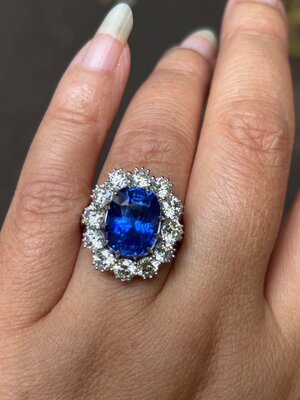mimspot
Rough_Rock
- Joined
- Dec 15, 2024
- Messages
- 6
Hey folks,
I have been exploring the world of antique and vintage blue sapphire rings. I was particularly drawn to this stone and setting:
 www.1stdibs.com
www.1stdibs.com
It has since sold, though sadly, not to me. I would still like to understand more about the particulars of it. Compared to similarly priced stones and settings that I have seen, it had many more eye visible inclusions than counterpart offerings, and I am curious about how it held value when compared to them despite those flaws. Maybe because of the color, size, or age?
If possible, would you be able to teach me about the types of inclusions in it from the pictures? In many of the photos there is a grouping of inclusions between 9 and 11 o'clock. I'm unable to tell if they are those of old, healing fractures, or crystals and minerals, or a combination thereof, or maybe something else? There is also then an inclusion of sorts that seems to twist through the middle down to the 4 to 5 o'clock area of the stone. Additionally, it seems to be a bit more translucent-looking, though it is described as transparent by the GIA evaluator--would this possibly be attributed to silk? Would any of these inclusions potentially weaken or shorten the life of the stone?
Thank you for any knowledge or thoughts you can share.
I have been exploring the world of antique and vintage blue sapphire rings. I was particularly drawn to this stone and setting:
GIA 18K Blue Sapphire Diamond Ring 12.04 TCW Unheated Ceylon Gold at 1stDibs | antique ceylon sapphire ring, antique sapphire blue
View this item and discover similar for sale at 1stDibs - Old South Jewels proudly presents... VINTAGE LUXURY. GIA CERTIFIED 18K GOLD HUGE 12.04 CARAT UNHEATED SAPPHIRE DIAMOND ANTIQUE RING & BOX! HUGE 9.52 CARAT
 www.1stdibs.com
www.1stdibs.com
It has since sold, though sadly, not to me. I would still like to understand more about the particulars of it. Compared to similarly priced stones and settings that I have seen, it had many more eye visible inclusions than counterpart offerings, and I am curious about how it held value when compared to them despite those flaws. Maybe because of the color, size, or age?
If possible, would you be able to teach me about the types of inclusions in it from the pictures? In many of the photos there is a grouping of inclusions between 9 and 11 o'clock. I'm unable to tell if they are those of old, healing fractures, or crystals and minerals, or a combination thereof, or maybe something else? There is also then an inclusion of sorts that seems to twist through the middle down to the 4 to 5 o'clock area of the stone. Additionally, it seems to be a bit more translucent-looking, though it is described as transparent by the GIA evaluator--would this possibly be attributed to silk? Would any of these inclusions potentially weaken or shorten the life of the stone?
Thank you for any knowledge or thoughts you can share.











300x240.png)